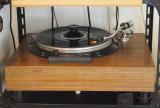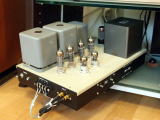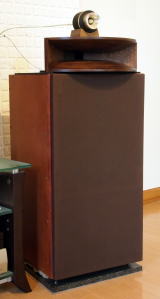Gaudi in 2014
2014/08/10 created
2021/05/07 updated
The contents of this page were reprinted from the previous homepage of mine, 'Tonochi's Audio Room'. Some parts were edited.
Gaudi has been under construction since 1974. It reached the 40th anniversary this year. In November 2012, it became nearly what I had planned in 1974
(block diagram), but it has been at a standstill since then. Completion of the midrange
amplifier MA-215 Arabesque will complete Gaudi at last. But I have many
challenges to finalize the design of MA-215. I'll mention the reason later.
By the way, I sold the cassette tape deck Excelia XK-007 I have been using
for 25 years. Instead, I purchased a digital recorder KORG MR-2000S-BK,
in order to digitalize analog sources (chiefly vinyl records). I would
like to make backup copies of the analog sources in case that they become
unable to be played for some reason. After making the backup copies, I
will never throw away my vinyl records because I am so attached to them
(I haven't throw away nor sold even a single record until now).
And, the MC head amplifier HA-213 was added to Gaudi, because the cartridge
of the analog disc player PS-104 was replaced with an MC cartridge.
As a result, Gaudi's configuration has become as follows:
[Block diagram]
I owned about 200 cassettes. Of these, I selected well-preserved 94 cassettes
and recorded them with XK-007 and the memory recorder TASCAM DR-1. The
recordings are saved as 48kHz/24bit WAV files in two hard discs (one for
backup copies). Just when I finished recording the last cassette, XK-007
got out of gear. I was impressed that it fulfilled its duty and came to
the end of its life. I'd like to express a special thanks to KX-007, which
have kept me satisfied for the past quarter century. I didn't dispose of
it, but sold it at a secondhand shop for 1,500 JPY.
Most of the cassettes were used for taping music on the FM radio. Many
pieces of rare music like crossover in late '70s or Japanese underground
folk music, which cannot be heard through other media today, were taped
on the cassettes. Now that they are digitized and saved in the hard discs,
they are my precious collection.
I didn't perform any edition to those WAV files except normalization of
the volume, though, I felt their tonal quality was improved.
The reason why I have some difficulty with the design of MA-215 is my decision
that it shall be a solid state amplifier, though it does not comply with
the original system design of Gaudi.
Until a few years ago, I believed that the vacuum tube is the better amplifying
element than the semiconductor for power amplifiers (for the ground of
my belief, see 'Merits of Tube Amplifiers' in the page 'Things Learned
from Gaudi').
However, I have been aware of many weak points of the tube amplifier lately
(I will explain the details in the page of MA-215 later). In particular,
the cost performance, which I regarded as the most important merit of the
tube amplifier, has been sharply declined due to the risen cost of parts
for tube amplifiers like transformers.
On the other hand, I became aware of strong points of the solid state amplifier.
The most important merit is its compactness. And less heat dissipation
is the next most important. A tri-amplified system like Gaudi needs three
power amplifiers. If all of them are tube amplifiers, it is difficult to
install them on the same audio rack. At least, an ideal layout is almost
impossible. If they are solid state amplifiers, this problem can be solved.
For these reasons, I decided to create the solid state power amplifier
MA-215. But it is my first time to design a solid state power amplifier
in my life, so I have a lot to learn and am stuck at the design now.
As for music source, I still believe the vinyl record is the best. On the other hand, I expect that the hi-res music file will be comparable with the vinyl as a high quality source. In recent years, I tried out a PC-based audio playback system composed of a PC and a USB-DAC such as KORG DS-DAC-10 or ONKYO WAVIO. I concluded that the system could be a high-end audio system if a few problems are solved such as adverse affect of electromagnetic waves radiated from the PC or the fan noise produced by the PC. (I'll write the details of the problems and the review of each USB DAC I used in 'Misc Info' later).
One of the purposes to add KORG MR-2000S to the system is replay of hi-res
music files with it. I expected that it would excel the PC-based playback
system in sound quality. I compared it with the combination of the PC (ThinkPad
X121e) and USB-DAC (KORG DS-DAC-10). As the result, I realized there is
no big difference between them. The PC-based system excels MR-2000S in
usability. So I decided to leave DS-DAC-10 in Gaudi.
Though MR-2000S is superb as a recorder, it's not so good as a player.
This is probably because using it as a player does not match the concept
of this product.
The PC-based playback system is one of the best means to play background music. Making a play list that contains a lot of pieces of music makes it possible to play music for a very long time without interruption.
One more new member of Gaudi is the MC head amplifier HA-213.
I designed and built it in 2010 in order that an MC cartridge could be
used, because I wanted an MC cartridge that replaces my favorite cartridge
GRACE F-14MR, which was degraded after used for over a quarter of century.
This amplifier was built after many twists and turns. I was not satisfied
with its performance. After many attempts to reduce noise, the noise level
was still higher than the target level. I judged it a failure. I stored
it in a closet because I planned to disassemble and rebuild it as a headphone
amplifier when I have time in the future (for further details, see the
page of HA-213).
Since May 2012, I have been using Ortofon 2M Red (MM type) as a substitute
of GRACE F-14MR. At last, I decided to purchase a high grade MC cartridge
comparable with F-14MR before the consumption tax hike in April 2014. After
thorough consideration, I chose Audio Technica AT33PTG/II (for the reasons
to choose them and reviews of them, see the page of PS-104).
At the time I bought AT33PTG/II, I bought a secondhand phono equalizer,
Ortofon EQA-333 too. I planned to use it for AT33PTG/II. But its input
impedance was too low for AT33PTG/II. I needed to customize it. Before
doing that, I tried out HA-213 and realized that it was far better than
I expected in sound quality, and its noise level was the same as EQA-333.
I decided not to customize EQA-333 and to use HA-213 till the completion
of NOBODY's phono equalizer PE-114 Petit.
I have been filled with rapture since Gaudi sound was dramatically improved by replacing the midrange module of SS-309 with the horn-loaded driver in 2012, but I began feeling deterioration of sound quality lately. The main cause must be the midrange amplifier, Flying Mole DAD-M100Pro, but I guess there is another cause. I have an idea about that. However, I have made completion of MA-215 my top priority. I will troubleshoot Gaudi after that.
Equipment
| Category | Model | Features | Description |
|---|---|---|---|
| ADP |  NOBODY PS-104 NOBODY PS-104 |
*Turntable: SONY TTS-8000 *Tone arm: GRACE G-1040 *Cartridge: audio-technica AT33PTG/II |
I've been using it w/o major modification since 1982. I changed the cartridge from MM type to MC type in 2014. I'll continue to use it as long as it works. |
| MC head amp |  NOBODY HA-213 NOBODY HA-213 |
Head amplifier for MC cartridges Gain = 30dB |
This amplifier was designed as a headphone amplifier at first. Before completion, it was re-designed as the MC head amplifier. Though its design is not perfect, a certain level of sound quality has been achieved. |
| DAP | SONY SCD-555ES | SACD/CD player | First generation SACD player. Also excellent as CD player having useful
features such as a digital filter selector. I've been using this since 2001. |
| DAP | Lenovo ThinkPad X121e | 11" laptop PC | Storage: 128GB SSD. The combination of this PC and DS-DAC-10 functions as digital audio player. It also functions as measurement instrument w/ PicoScope. |
| DAP | KORG DS-DAC-10 | USB DAC | The combination of this device and ThinkPad functions as digital audio player. The highest resolution is PCM 192kHz/24bit and DSD 5.6MHz. |
| Tuner | SONY ST-S333ESJ | Highly functional FM/AM tuner | Although it has various features, I use only basic ones. The sound quality is not so good because the FM radio waves, supplied from a cable TV station, are not strong enough. |
| DAR | KORG MR-2000S-BK | 1-bit digital recorder | Digital recorder for studio use. It is also available in the retail market.
The highest resolution is PCM 192kHz/24bit and DSD 5.6MHz. It is used for recording vinyl discs and playing hi-res music files. |
| Preamp |  NOBODY PA-210 Simplicity NOBODY PA-210 Simplicity |
Tube preamplifier All stages are SRPP CR-type phono equalizer Non-NFB flat stage Separate power supply |
A tube preamp made in 2001-2003. Featured by out-and-out simplicity and low noise. |
| Network |  NOBODY CD-211A A-NET NOBODY CD-211A A-NET |
Solid state Three-way channel divider (network) |
The first NOBODY-branded model that uses OP amps. Made in 2004. Revised
in 2012. Crossover frequencies: 800Hz(18dB/oct), 7200Hz(18dB/oct) |
| Tweeter amp |  NOBODY MA-208 NOBODY MA-208 |
Tube power amplifier 6BQ5 UL PP |
Designed for horn-loaded tweeters. Made in 1999. Split load phase splitter; rectifying tube. Output power: 10W+10W |
| Midrange amp | Flying Mole DAD-M100pro HT |
Mono digital power amplifier | Power amp for midrange/full-range. Warm sound like tube amp. Output power: 100W (8ohm) |
| Woofer amp | Tube power amplifier 6CA7 UL PP |
The first NOBODY-branded equipment, made in 1974. Used for woofers. The current revision: C Output power: 30W+30W | |
| Loudspeaker |  NOBODY SS-309A NOBODY SS-309A |
Three-way speaker system *Tweeter: Fostex T925A *Midrange: Fostex D1405+H400 *Woofer: Fostex FW305 |
12" woofer-based three-way loudspeaker, made in 2001. It doesn't include network and attenuator since it's designed for the multi-amplifier system. Vented box for woofer. The midrange unit was changed from full-range direct radiator to horn-loaded midrange in 2012 (Rev. A). |
| Pnono cable | PS-104 -> PA-210 | GRACE genuine cable (RCA plugs has been replaced) |
Low capacitance cable using LC-OFC. In 2011, the RCA plugs' solder joints corroded and the cable was disconnected. The RCA plugs were replaced with new ones using PTFE insulator. Sound quality has been a bit improved. |
| Line cable | SCD-555ES -> PA-210 | Handmade cable *Wire: BELDEN 8412 *Plug: Teflon RCA plug |
Handmade cable made of balanced type shield wire. Though the RCA plug is
a generic one, the insulator material is teflon. The plug's metal cover is not attached. Shrink tube is applied instead. |
| Line cable | PA-210 -> CD-211A | Handmade cable *Wire: BELDEN 8412 *Plug: Teflon RCA plug |
Handmade cable composed of balanced type shield wires. One end of the cable is soldered in CD-211A. |
| Line cable | CD-211A -> MA-208 | Handmade cable *Wire: BELDEN 8412 *Plug: Teflon RCA plug |
Handmade cable composed of balanced type shield wires. One end of the cable
is soldered in CD-211A. The wires were Audio Technica AT6A48 when CD-211 was built (2004). They were replaced with BELDEN 8412 in 2008. BELDEN is unquestionably superior. The metallic cover of the plug was replaced with a thermal shrink tube. |
| Line cable | CD-211A -> DAD-M100pro | Handmade cable *Wire: BELDEN 8412 *Plug: Teflon RCA plug |
Handmade cable composed of balanced type shield wires. One end of the cable is soldered in CD-211A. |
| Line cable | CD-211A -> MA-201C | Handmade cable *Wire: BELDEN 8412 *Teflon RCA plug |
Handmade cable composed of balanced type shield wires. One end of the cable is soldered in CD-211A. |
| Speaker cable | MA-208 -> SS-309A tweeter | Handmade cable *Wire: 47 Laboratory STRATOS *Plug: none |
Handmade cable made of 0.4mm copper single wires twisted at 30cm pitch. One end of the cable is soldered to the output terminal of MA-208. The other end is plated w/ silver loaded solder. |
| Speaker cable | DAD-M100pro -> SS-309A midrange | Handmade cable *Wire: 47 Laboratory STRATOS *Plug: banana plug for isntruments |
Handmade cable made of 0.4mm copper single wires twisted at 30cm pitch. Banana plugs for measurement instruments are attached to one end. The other end has no connector. |
| Speaker cable | MA-201C -> SS-309A woofer | Handmade cable *Wire: 47 Laboratory STRATOS *Plug: none |
Handmade cable made of 0.6mm copper single wires twisted at 30cm pitch. One end of the cable is soldered to the output terminal of MA-201C. The other end is directly soldered to the terminal of woofer. |
| Room | 25m2 living room | Fairly soundproofed. Slightly live at mid and high frequencies and slightly dead at low frequencies. Almost no standing waves thanks to the slant ceiling. Acoustics is tuned by using acoustic panels, sound absorbing panels and sound absorbing curtain. Equipped with outlets for audio equipment; both 100V and 200V. The sockets are for medical use. |